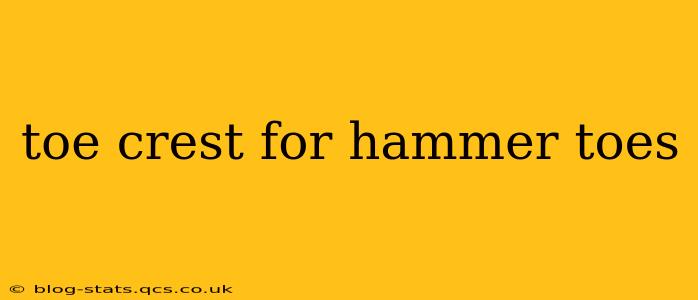Hammer toes, characterized by a bent middle joint that resembles a hammer, can cause pain, discomfort, and difficulty wearing shoes. A toe crest is often mentioned as a potential solution, but understanding its role and effectiveness requires a closer look. This comprehensive guide explores toe crests and their application in managing hammer toes, addressing common questions and concerns.
What is a Toe Crest?
A toe crest, often incorporated into footwear or available as a standalone orthotic device, is a raised section or pad positioned beneath the toe's metatarsal head (the ball of the foot) at the base of the affected toe. Its primary function is to provide cushioning and support, thereby reducing pressure and friction on the affected joint. The design aims to gently lift the toe and straighten the bent joint, alleviating the pressure that contributes to pain and discomfort. While a toe crest might offer some relief, it's crucial to understand it isn't a cure for hammer toes.
How Does a Toe Crest Help with Hammer Toes?
A toe crest works by subtly altering the mechanics of the foot. By elevating the metatarsal head, it reduces the flexion (bending) of the proximal interphalangeal (PIP) joint – the joint that is usually affected in hammer toes. This reduction in flexion can:
- Decrease pain: By lessening pressure on the bent joint, the toe crest can significantly reduce pain and discomfort, especially when wearing shoes.
- Improve comfort: The cushioning effect adds an element of comfort, preventing the toe from rubbing against the inside of the shoe.
- Prevent further deformity: While it won't reverse existing deformity, a toe crest can help prevent the hammer toe from worsening.
What are the Different Types of Toe Crests?
Toe crests are incorporated into various products:
- Shoes: Many shoes designed for individuals with foot problems incorporate built-in toe crests into their design. Look for shoes labeled as "orthopedic" or "diabetic shoes."
- Orthotics: Custom or over-the-counter orthotics can be fitted with toe crests to provide targeted support.
- Silicone Toe Separators/Pads: These are readily available and offer a simple, often temporary solution for cushioning and mild toe straightening.
Can a Toe Crest Cure Hammer Toes?
No, a toe crest cannot cure hammer toes. It's a palliative measure, providing relief and support but not addressing the underlying cause of the deformity. Hammer toes often stem from muscle imbalances, nerve damage, or structural issues. For significant or progressive hammer toes, professional medical advice is necessary.
Are There Any Side Effects of Using a Toe Crest?
While generally safe, some individuals might experience minor side effects, such as:
- Skin irritation: Friction from the toe crest might lead to irritation, especially if the material isn't breathable or properly fitted.
- Discomfort: If the toe crest isn't properly positioned or sized, it can cause more discomfort than relief.
- Calluses: Improperly fitted toe crests could increase pressure in other areas, leading to callus formation.
What Other Treatments Are Available for Hammer Toes?
Beyond toe crests, numerous treatments exist, depending on the severity of the condition. Options include:
- Conservative management: This includes wearing supportive footwear, using orthotics (including toe crests), and performing stretching and strengthening exercises.
- Medication: Pain relievers can help manage discomfort.
- Surgery: In severe cases where conservative treatment fails, surgery might be necessary to correct the deformity.
When Should I See a Doctor About My Hammer Toes?
Consult a podiatrist or doctor if:
- Your hammer toes are causing significant pain or discomfort.
- Your hammer toes are worsening or interfering with your daily activities.
- You develop any signs of infection, such as redness, swelling, or pus around the affected toe.
Can I Make My Own Toe Crest?
While it's possible to try DIY solutions, it's generally not recommended. Incorrectly positioned or sized homemade toe crests could worsen the problem. Professional guidance is crucial for appropriate support and treatment.
This information is for general knowledge and does not constitute medical advice. Always consult a healthcare professional for diagnosis and treatment of hammer toes or any foot-related conditions. They can assess your specific situation and recommend the most suitable course of action, including the appropriate use of toe crests or other treatment options.
